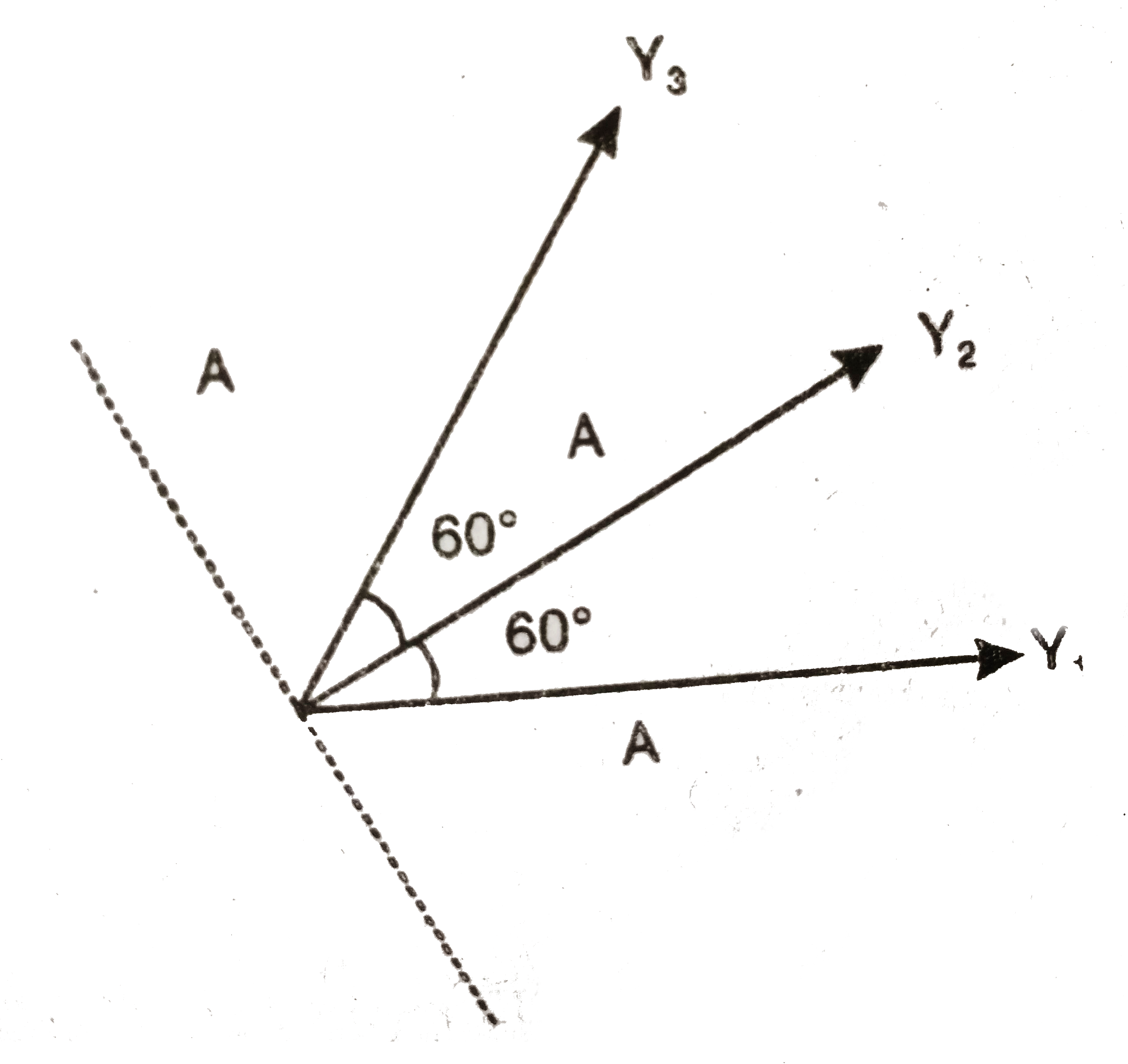Three simple harmonic motions of equal amplitudes A and equal time periods in the same direction combine. The phase of the second motion is 60∘ ahead of the first and the phase of the third motion is 60∘ ahead of the second. Find the amplitude of the resultant motion.Solution in Tamil
The correct Answer is:A, B
Three SHMs of equal amplitudes AS and equal time period in the same direction cobine. The vectors representing the three SHMs are shown in the ure using vector method.

Resultant ampllitude
=vector sum of the three vectors
=A+acos60∘+Acos60∘
=A+A2+A2=2a
So, the amplitude of the resultant motion is 2A.
Topper's Solved these Questions
- SIMPLE HARMONIC MOTIONBOOK - HC VERMACHAPTER - SIMPLE HARMONIC MOTIONEXERCISE - Objective-2
16 Videos
- ROTATIONAL MECHANICSBOOK - HC VERMACHAPTER - ROTATIONAL MECHANICSEXERCISE - Exercises
86 Videos
- SOME MECHANICAL PROPERTIES OF MATTERBOOK - HC VERMACHAPTER - SOME MECHANICAL PROPERTIES OF MATTEREXERCISE - Exercises
32 Videos
Similar Questions
Select the correct statements
View SolutionA wheel is making revolutions about its axis with uniform angular acceleration. Starting from rest, till it reaches 100 rev/sec in 4 seconds. Find the angular acceleration.
View SolutionA load of 10 kg is suspended by a metal wire 3 m long and having a cross sectional area 4mm2. Find a. the stress b. the strain and c. the elongation. Young modulus of the metal is2.0×1011Nm−2
View SolutionA particle is subjected to two simple hasrmonic motions in the same direction having equal amplitudes and equal frequency. If the resultant amplitude is equal to the amplitude of the individual motions, find the phase difference between the individual motions.
View SolutionA particle is subjected to two simple harmonic motions of sae time period in the same direction. The amplitude of the first motion is 3.0 cm and that of the second is 4.0 cm. Find the resultant amplitude if the phase difference between the motion is a. 0∘,b.60∘,c.90∘
View SolutionA particle is subjected to two simple harmonic motion in the same direction having equal amplitudes and equal frequency. If the resultant amplitude is equal to the amplitude of the individual motions. Find the phase difference between the individual motions.
View SolutionThree simple harmonic motions in the same direction each of amplitude a and periodic time T , are superposed. The first and second and the second and third differ in phase from each other by (pi)/(4) , with the first and third not being identical . Then.
View SolutionTime S.H.M. of equal amplitude a and equal time period in the same direction combine. The first is 60∘ ahead of the second and second is 60∘ ahead of the third S.H.M. The amplitude of the resultant oscillation is:
View SolutionA particle is subjected to two simple harmonic motions in the same direction having equal amplitude and equal frequency. If the resultant amplitude is equal to the amplitude of individual motions, what is the phase difference between the motions.
View Solution(a) A particle is subjected to two SHMs of same time period in the same direction. If A1=6cm, A2=8cm, find the resultant amplitude if the phase difference between the motions is (a) 0∘, (b) 60∘, (c) 90∘ and (d) 120∘.
(b) In the previous problem if A1=A2=a and resultant amplitude is also a, find phase difference between them.
(c) Three SHMs of equal amplitude A and equal time periods in the same direction combine. The phase of the second motion is 120∘ ahead of first and the phase of the third motion is 120∘ ahead of the second. Find the amplitude of the resultant motion.
View SolutionA particle is subjected to two simple harmonic motions in the same direction having equal amplitudes and equal frequency. If the resulting amplitude is equal to the amplitude of individual motions, the phase difference between them is
View SolutionA particle is subjected to three SHM's in same direction simultaneously each having amplitude a and equal time period. The phase of the second motion is 30^(0) ahead of the first and the phase of the third motion is 30^(0) ahead of the second. Find the amplitude of the resultant motion.
View Solutionएक दिशा, एक ही आयाम A तथा एक ही आवर्तकाल की तीन सरल आवर्त गतियों का संयोजन हो रहा है। दुसरी गति पहली से 60∘ कलांतर से आगे है तथा तीसरी गति दूसरी गति से 60∘ के कलांतर से आगे है। परिणामी गति का आयाम निकालें।
View SolutionA particle is subjected to two simple harmonic motions in the same direction having equal amplitudes and equal frequency. If the resultant amplitude is equal to the amplitude of the individual motions, find the phase difference between the individual motions.
View SolutionA particle is subjected to two simple harmonic motions of same time period in the same direction. The amplitude of the first motion is 3.0 cm and that of the second is 4.0 cm. Find the resultant amplitude if the phase difference between the motion is a. 0^@, b. 60^@, c. 90^@
View SolutionA particle is subjected to two simple harmonic motions in the same direction having equal amplitudes and equal frequency. If the resulting amplitude is equal to the amplitude of individual motions, the phase difference between them is :
View Solution